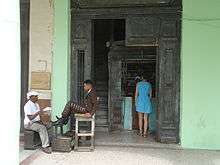Shoeshiner
Shoeshiner or boot polisher is an occupation in which a person cleans and buffs shoes and then applies a waxy paste to give a shiny appearance and a protective coating. They are often known as shoeshine boys because the job was traditionally done by a male child. Other synonyms are bootblack and shoeblack. While the role is denigrated in much of Western civilization, shining shoes is an important source of income for many children and families throughout the world. Some shoeshiners offer extra services, such as shoe repairs and general tailoring. Some well-known people started their working life as shoeshiners, including singers and presidents.

History
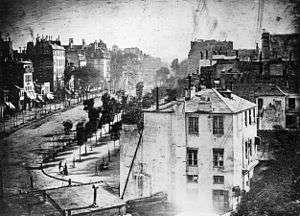
Shoe polish was not well known as a commercial product until the early 20th century. Throughout the late 19th century shoeshine boys plied their trade on the streets, particularly those in the cities of the United Kingdom. The earliest known daguerreotype (photograph) of a human, View of the Boulevard du Temple, features a man having his shoes shined in the lower corner of the print.[1] Though the image shows Paris' busy Boulevard du Temple, the long exposure time (about ten or twelve minutes) meant that moving traffic cannot be seen; however, the two men at lower left (one apparently having his boots polished by the other) remained still long enough to be distinctly visible.

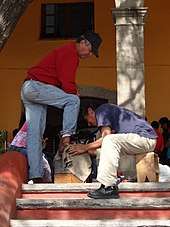
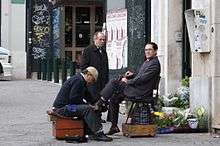
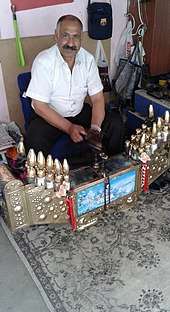
Modern profession
The profession is common in many countries around the world, with the revenue earned by the shoeshiner being a significant proportion of a family income, particularly when the father of the family has died or can no longer work.[2] In Afghanistan some children will work after school and can earn 100 Afghanis (around £1) each day.[3] Many street children use shoeshining as their only means of income.
Some cities require shoeshiners to acquire licences in order to work legally. In August 2007 shoeshiners in Mumbai, India were told that they could no longer work on the railway stations due to "financial irregularities". Every Shoeshine Association was asked to reapply for their licence, with many worried that they would lose out to a rival.[4]
Famous shoeshiners
Several high profile figures worked as shoeshiners at one point of their lives:
- Mahmoud Ahmed – Ethiopian singer[5]
- James Brown – "The Godfather of Soul". He used to shine shoes and sing and dance on 9th Street in Augusta, Georgia; in 1993 the road was renamed "James Brown Boulevard" in his honour.[6][7]
- Luiz Inácio Lula da Silva – later President of Brazil[8]
- Alejandro Toledo – later President of Peru[9]
- Malcolm X – worked as a shoeshine boy at a Lindy Hop nightclub in New York City[10][11]
- Rod Blagojevich – later Governor of Illinois[12]
- Sammy Sosa Former Dominican baseball player predominately for the Chicago Cubs[13]
- Čika Mišo, last Bosnian shoeshiner[14]
- Willie Brown, San Francisco Mayor and Speaker of the California Assembly
Portrayal in popular culture
Shoeshiners have featured in:
Film and television
- Shoe Shine Boy, a 1943 film musical
- Shoeshine, a 1946 Italian film which received honours at the 1948 Academy Awards
- Boot Polish, a 1954 Hindi film
- El Bolero de Raquel, 1956 Mexican film starring Cantinflas
- Prince of Space, a 1959 science-fiction film
- Underdog, a 1964 animated television series in which an anthropomorphic dog, Shoeshine Boy, battles crime as the titular canine superhero.
- The Adventures of Timothy Pilgrim, a 1975 Canadian children's TV series
- Goodfellas, Martin Scorsese's 1990 gangster film, features a scene in which hair trigger-tempered Lucchese crime family wiseguy, Tommy DeVito (Joe Pesci), brutally beats Gambino crime family mobster, Billy Batts (Frank Vincent), for insulting him about being a shoeshine boy in Tommy's younger days. The film is based on the real-life experiences of Henry Hill and the people he met through the Vario brothers, who owned a shoeshine stand and other businesses. In real life, William "Billy Batts" Bentvena taunted Thomas "Two Gun Tommy" DeSimone, calling him "spit-shine Tommy". DeSimone retorted by yelling, "Shine these fuckin' shoes", and then executing Batts.[15]
- Parks and Recreation, a 2009 American TV show, in which Andy Dwyer, one of the main characters gets a job in Pawnee City Hall shining shoes.
- Le Havre, Aki Kaurismäki, 2011
- Coco , Miguel, a 2017 film that the character shoeshined a musician shoes as a former job before he went shoemaking.
Literature and publications
- Ragged Dick, an 1867 dime novel by Horatio Alger, Jr. about a poor but honest shoeshiner and his rise to middle-class comfort and respectability through good moral behavior, clean living, and determination. Shine!, a musical based on Alger's work, particularly Ragged Dick, was produced in 1982.
- Rajbahadur Bakhia the arch-villain in novels of Surender Mohan Pathak, was originally a shoeshiner at flora fountain area of Mumbai, and had his introduction with underworld over a payment dispute with a small-time gangster who refused to pay him.
- Scrooge McDuck, the Dell Comics character, famously won his Number One Dime shining shoes.
Music
- "Chattanoogie Shoe Shine Boy", a song performed by Bing Crosby and Frank Sinatra amongst others
- The opening lines of "Chattanooga Choo Choo" are dialogue between a passenger and a shoeshine boy
- "Shoeshine Man", a song by Tom T. Hall
See also
References
- Easby, Rebecca Jeffrey. "Daguerre's Paris Boulevard". Retrieved 8 January 2014.
- HASCO. "Poverty forces Afghan children to quit school to work". Accessed 20 August 2007.
- BBC News. "Photo journal: Kabul's street children". Accessed 20 August 2007.
- Yahoo! News India. 6 August 2007. "Mumbai plans to 'polish' off its shoeshine boys". Accessed 20 August 2007.
- Cartwright, Garth. BBC News. 2007. "Mahmoud Ahmed". Accessed 20 August 2007.
- Rogers, Richard. WRDW. 25 December 2006. "James Brown: Legend, believer, Augusta son". Accessed 24 August 2007.
- Augusta Convention & Visitors Bureau. "James Brown Boulevard Archived 2007-09-28 at the Wayback Machine". Accessed 24 August 2007.
- Smith, Rodney. BBC News. 13 January 2003. "Brazil braces for testing times". Accessed 20 August 2007.
- BBC News. 8 April 2001. "Toledo: Shoeshine boy turned economist". Accessed 20 August 2007.
- Cooper, Kenneth J. The Boston-Bay State Banner. 16 February 2006. "February 021606-03.htm Malcolm: The Boston years". Accessed 24 August 2007.
- SparkNotes. "SparkNotes: The Autobiography of Malcolm X". Accessed 24 August 2007.
- Copley News Service. Three Democrats battle for party's nomination for governor. March 9, 2002.
- Congressional Record, V. 144, Pt. 14, September 9, 1998 to September 21, 1998
- Preminuo čika Mišo,legenda Sarajeva
- Allan May. "The Lufthansa Heist Revisited: The End of Tommy DeSimone". TruTV.com TruCrimeLibrary. Retrieved 12 December 2010.
External links
| Wikimedia Commons has media related to Shoeshiners. |
- Luard, Tim. BBC News. 16 September 2004. "China diary: Shanghai shoeshine".
- BBC News. 28 September 2004. "Belfast Shoe Shine Boy".
